The release of Bing Webmaster Guidelines (finally) came as a big news to the SEO
community. It helps webmasters and publishers get their content found and indexed
on the search engine.
With the release of the new Bing Webmaster Guidelines, the company is committing to
being a webmaster-friendly service that puts their needs at the top-of-mind, and
although the Guidelines aren’t much different than Google’s, they do provide a great
refresher on what how Bing crawls, ranks and indexes sites.
Let’s take a look at some important points:
Content
Webmasters must provide “clear, deep, easy to find content” on their sites that make it
more likely to be found, and ultimately indexed and shown in search results. This also
includes images, white papers and videos, among other types. Rich, content-heavy
sites that engage users and provide valuable and refreshed information are always the
most sought after.
Social
Bing frequently points to social sharing signals as a major way that the search engine
measures influence. And since Facebook has significantly more users than Google+,
Bing may very well become the standard search engine for socially inclined search
results.
Indexation
Bing explains that the best ways to be indexed by the search engine is to either link
your content to Bing or use features that come with the Bing Webmaster Tools (e.g.
Submit URL or Sitemap Upload) to make them aware of your content.
Technical
This section of the Bing Webmaster Guidelines examines a variety of different
structural aspects of a website that can affect how they are crawled, indexed and
eventually ranked on Bing’s SERPs. These include page load time, robots.txt, sitemaps,
site technology, redirects and canonical tags.
Search Engine Optimization
The section directly distinguishes the key areas to put emphasis on when optimizing
their websites, which include title tags, meta description tags, alt tags, <h1> tags,
internal links, outbound links, social sharing, “crawlability” (i.e. XML sitemaps,
robots.txt, navigational structure, URL structure, etc.), site structure (i.e. links, clean
URLs, content hierarchy, etc.) and rich media.
It also breaks down specific on-page SEO information about head copy, body copy,
anchor text, content and links. For instance, it suggests using unique, relevant titles and
descriptions that are around 65 and 160 characters, respectively. The Guidelines also
inform webmasters that they should only use one <h1> tag per page, base their content
on keyword research, don’t use images to house content, use targeted keywords as
anchor text to support other internal pages, use “rel=canonical” tags to help engines
understand which pages they should index and much more.
Tactics To Avoid
Bing Webmaster Guidelines also mention a handful of different tactics that webmasters
should avoid. In particular, the Guidelines warn against cloaking, using link building
schemes (i.e. link farms, three-way linking, etc.), meta fresh redirects, duplicate content
and social media schemes.
While the suggestions laid out in the Bing Webmaster Guidelines aren’t revolutionary,
they do work as a great source of information for webmasters as they work to optimize
their sites for search engines, particularly if they want to improve their Bing rankings.

